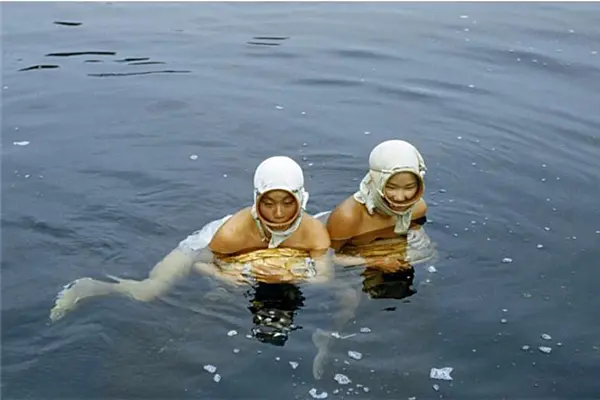The deep crevices etched in Reiko Nomura’s face seem to tell an ancient story, a story of joy and hardship, intimately connected to the sea and a Japanese tradition of female free divers that dates back 3,000 years.
Nomura, who began diving along the jagged coast around the Shima Peninsula, central Japan, in childhood with her mother, dived until the age of 80. Like all female divers, no one taught her how to dive. It is a skill she learned on her own.
Before her at Hachimankamado, a restaurant that’s the base for elderly divers like her, a feast is laid out ready to grill, including abalone, Japanese spiny lobster, turban snails andhijiki(a brown sea vegetable).
“This is a real feisty one,” says another diver, Mitsue Okano, 70, pointing to the lobster wiggling in her hand before she pierces it nonchalantly with a skewer.
A seafood lover’s dream, all of the food served here is taken from the sea around the Shima Peninsula. The abalone is succulent to the core. Though too leathery for some, the turban snails are also a delight.
All of the women at Hachimankamado arekachido ama, who swim out or take a boat in a group from the seashore and use a basket and a weighted belt to dive unassisted for abalone and other shellfish at depths of three to four metres. These divers are normally novices or older divers who can no longer dive to deeper depths.
Funado ama, on the other hand, dive in deeper waters farther offshore, accompanied by a boatman (usually their fishermen husbands), sometimes descending to depths of 15-20 metres. When they run out of breath, they give a tug on a rope to be hoisted back by the boatman’s pulley.
“Before in this village of Osatsu, as a woman, unless you could dive, you had no chance of getting married. So as children while swimming in the ocean, we all learned this skill. Over and over we practised holding our breath and diving very deep,” Okano says.
“We can dive 10 meters in one minute, and when we surface we do a sea whistle as a natural way to regulate our breathing before diving again,” she says, before demonstrating the whistle, which sounds like a high-pitched sigh.
Nomura recalls diving when she was nine months pregnant with her son Kazuhiro and giving birth to him the very next day. Kazuhiro, 55, is now the mayor of Hachimankamado.
“I caught a lot of sea urchin that day,” she says.
Until the 1960s, many women free divers worked topless, wearing only a loincloth. The practice soon began dying out with the advent of the wetsuit in Japan in the 1970s.
A typical free diver will hold her breath under water for about 50 seconds while searching for abalone, which must be pried loose from rocks with a chisel. The cardinal rule of free diving is not to defy nature. This means no matter how physically fit, no matter how great one’s lung capacity, a diver should never risk her life and always resurface with room to spare.
In 1956, there were more than 17,500 women divers in Japan, according to a Toho University study, but that number has plummeted. In 2010, the Shima Peninsula had the largest number, close to 1,000, but that figure had dropped to 761 by 2014, according to the Toba Sea-Folk Museum. Currently, there are about 2,000 women divers in Japan. A microcosm of its aging population, they average 65 years old.
The only other country with a similar tradition of women diving to collect shellfish is South Korea, where there are approximately 10,000 female free divers in South Korea, the majority of whom fish off Jeju Island. Women divers have been hosting a yearly summit with their South Korean counterparts in an effort to have their tradition added to Unesco’s intangible cultural heritage list.
 简体中文
简体中文

